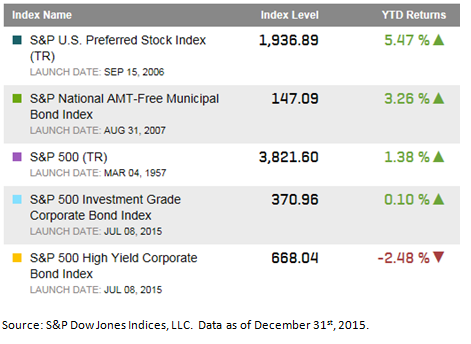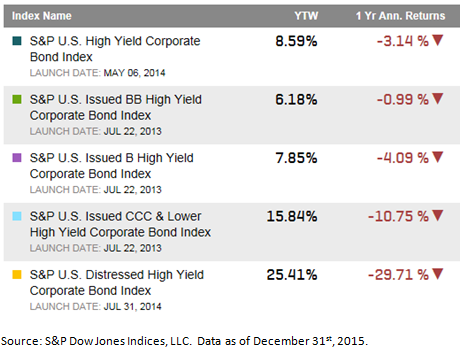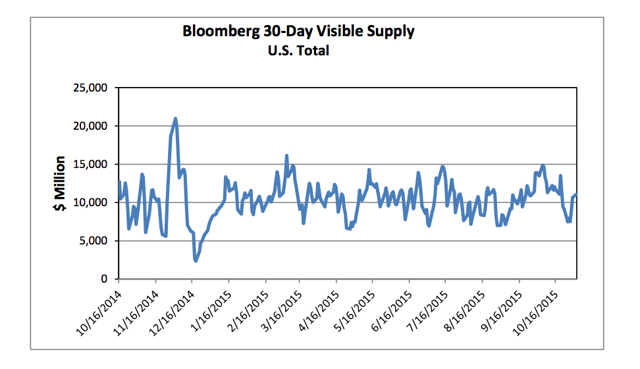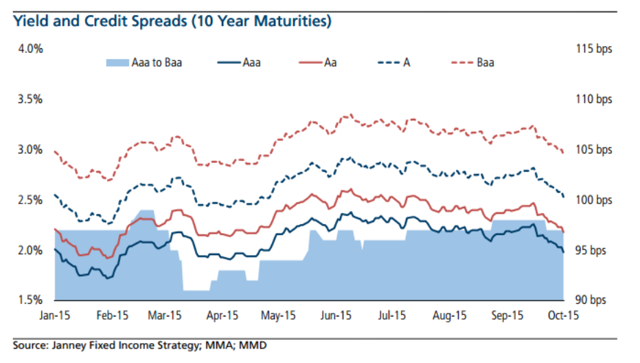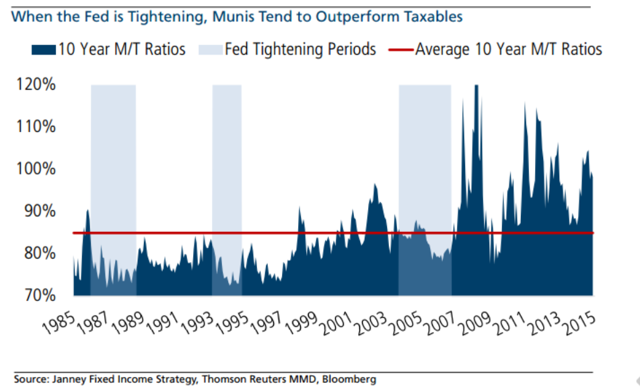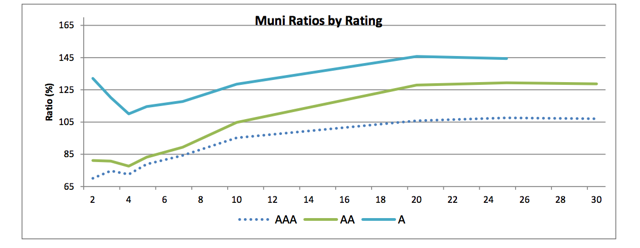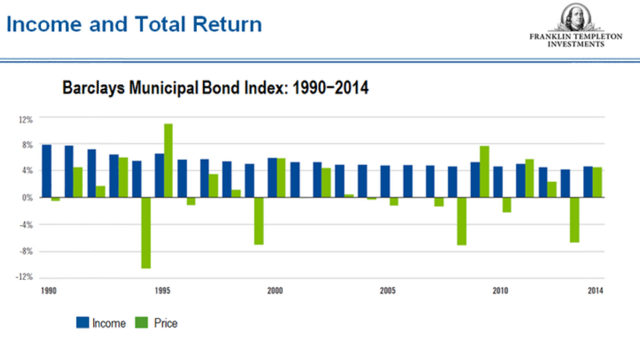Municipal experts awaiting this week’s Federal Reserve’s decision on interest rates said a host of other stressors — from a lack of supply and credit concerns to unfunded pension liabilities and yield-curve positioning — were high on their list of concerns.
It’s been a year of headline-making news for troubled municipalities, political and government leaders, municipal legislation, market trends and federal regulation, but municipals took it in stride, according to analysts.
“Municipal investors have undergone a nerve-wracking couple of years, having to contend with the irrational threat of rising rates, the downgrade of very high-profile credits, the potential for market dislocating defaults, a shrinking high-yield sector and sporadic liquidity flare-ups — just to name a few,” Vikram Rai, head of Citi’s municipal strategy group wrote in a Dec. 3 municipal outlook called “A Year on the Edge.”
And 2015 was no different. It had its share of everything from general market and seasonal volatility, to credit distress and fiscal debacles, and high-profile bankruptcies and defaults. Municipal analysts, strategists, portfolio managers, and experts reflecting on 2015 said, at times, there were more downs than ups.
Dan Heckman, senior fixed-income strategist at U.S. Bank Wealth Management, said a lack of net new supply was most problematic for him this year.
He said he was challenged to find municipal bonds that fit into his investment-grade quality bias and longer-term investment parameters. U.S. Bank Wealth Management manages $130 billion of total assets, but declined to disclose the amount of municipal assets under management.
Initially, heavy refunding activity in the first half of 2015 gave Heckman hope for more robust volume throughout the second half of the year.
“That really gave us a firm confidence that the market would do very well this year in the face of rising rates,” he said on Dec. 1. But his thesis “took a hit” mid-year, and “the decline in new issuance is actually getting worse, not better as we finish this year,” Heckman said.
LACK OF SECONDARY TRADING
“We have tried to overcome a lack of supply in investment-grade bonds,” he said. “We have tried very aggressively buying everything we see, but it’s very hard when there is not a lot of secondary trading.” He said recent layoffs in fixed-income trading operations contributed to the lack of trade flow and availability of bonds this year.
In a market and economic report released a day after his interview with The Bond Buyer, Heckman held out hope for a late-year supply burst.
“We expect issuance to surge in the month of December due to an above-average maturity schedule,” he wrote in a report for the week of Nov. 30. “In addition, this may be the last chance for issuers to refinance their debt prior to the Fed beginning to normalize the policy rate. The recent flattening of the yield curve could also add to the issuer incentive to refund in December,” he said in the report.
Heckman said the prospect of rising rates could have a swifter impact on the short end of the yield curve, and that he continues to be pressed to find long-term paper to fit his needs at year end.
“We believe bond portfolios should focus on an average maturity of five to seven years, and should include normal allocations to longer-term bonds, rather than focusing on short-term bonds,” he wrote in his Dec. 2 report.
“We would emphasize credit exposures since spreads are fair relative to high-quality securities, and the premium offered for lower-quality credits tends to compress in rising interest rate regimes,” he said. Heckman said buyers can find some benefits from the relatively steep muni yield curve since it mirrors the Treasury curve.
“This offers investors some ‘extra’ yield to compensate for the risk of longer maturities in a rising rate environment,” Heckman added. He is, however, avoiding certain credits, particularly those struggling with pension liabilities.
Anthony Valeri, senior vice president and investment strategist at LPL Financial, said the potential Fed rate hikes will be a headwind for municipals going into 2016.
“While they have historically held their value slightly better than comparable Treasuries during periods of rising rates, [municipal bonds] cannot completely disconnect from rate hikes,” he wrote in a Dec. 8 fixed-income outlook.
Valeri believes a significant increase in overall municipal debt growth is unlikely in the remainder of 2015. “States and municipalities battle with still-tight budgets that will likely keep bond issuance for new infrastructure projects limited,” he wrote in his report.
Valeri also believes net supply is likely to be limited in 2016, which should provide support to prices. “Like taxable bonds, municipal bonds are likely to witness a low-return environment as well and not escape the challenges facing all bond investors in 2016,” he wrote.
John Mousseau, director of municipal investments at Cumberland Advisors, said the relative attractiveness of municipal bonds was one thing that remained consistent through the year, amid volatility in credit, liquidity and issuance. He said there may be some added opportunities to pick up attractive municipals if a late December supply burst surfaces as issuers attempt to current-refund bonds with 2016 call dates.
“This will be large, but not like the bulge we saw last year,” he said in a recent interview. “In any case, munis of higher- grade variety at 4% are still a giveaway, in our opinion.”
But the opportunity could be short-lived depending on when the Fed decides to act, Mousseau said. He said once the Fed hikes begin, muni-Treasury yield ratios could decline, partly due to higher Treasury yields and declining municipal yields as the municipal supply subsides.
AVOIDING NEGATIVE ARBITRAGE
“If you go to decently lower ratios, that will prompt a flood of advanced refundings with calls out in the 2021 range,” he said. He said many issuers have largely focused solely on advance-refunding bonds out to 2018 and 2019 to avoid the negative arbitrage beyond those years eating into the cost savings.
That behavior could change, however, based on potentially declining ratios.
“With a roll-down the yield curve and lower ratios, refundable bonds with calls from 2021 to 2023 come into play,” Mousseau said. The municipal-to-Treasury ratios will most likely end 2015 near their five-year average, according to Valeri of LPL.
As of Dec. 1, the 30-year ratio was at 104% and the 10-year at 95% — just slightly lower than the start of November, when there was intermediate- and long-term bond outperformance, he said. “We think that the recent strength signals near-term caution, but believe that municipal bonds have attractive long-term valuations,” Valeri noted.
Peter DeGroot, managing director at JPMorgan Securities predicts municipals will outperform Treasuries on a relatively modest lift in long-dated yields. By mid-year 2016, “we believe that the Federal Reserve will have established a gradual approach to normalizing interest rates,” DeGroot wrote in a Nov. 25 municipal market outlook.
He estimates that the two, five, 10-year and 30-year U.S. Treasury yields will be at 1.35%, 2.10%, 2.50% and 3.15%, respectively, about halfway through 2016, and further rising to 1.75%, 2.50%, 2.75% and 3.25%, respectively, by year end.
“Below expected economic growth would serve to limit the Fed tightening cycle and keep the curve closer to its current shape and absolute levels than we have forecast,” DeGroot added.
POLICIES DIVERGE
Dawn Mangerson and Jim Grabovac, co-portfolio managers at McDonnell Investment Management in Oakbrook, Ill., said economic and monetary policy divergence was the key driver of capital market returns and valuations across global markets in 2015.
The consequence was a further strengthening of the dollar that added downward pressure on commodity prices broadly.
“This guided our expectations toward a benign outlook for inflation and limited upside potential for longer-term interest rates in the U.S.,” the managers wrote in a Nov. 30 email.
Going forward, they expect economic and monetary policy to play an “outsized” role in 2016. Economic recovery entering its seventh year and additional labor market gains could afford the Federal Reserve “the opportunity to boost short-term rates off the zero-lower bound for the first time since 2008,” they wrote.
“With global growth moderating, however, and relatively large interest rate differentials in favor of the U.S., we expect a stronger dollar will continue to dampen inflation and U.S. growth at the margin, thereby limiting both the scope and the alacrity with which the Fed pursues its attempt at policy normalization.
Analysts said 2016 should offer a fresh start and new value opportunities for municipal investors, even if volume is down.
JPMorgan forecasts net supply of negative $58 billion in 2016, and approximately negative $58 billion in issuance over 2016 — a 20% decrease from the negative $73 billion expected for full year 2015.
The seasonal factors approaching 2016 appear to be displaying a typical pattern with heavy mid- and end-of-year coupon and redemption periods showing low net supply, according to DeGroot of JPMorgan.
In addition, net supply is expected to support prices during January and February, with net negative $16 billion in supply over the two month period, he said.
“In 2015, expected richening of ratios in the January-February period failed to materialize as 10-year U.S. Treasury yields fell to two-year lows of 1.67%, and supply for the two months was a near record $62.5 billion,” DeGroot wrote.
July and August saw net negative supply of $34 billion, or 24% above forecasted net supply for these months, he added. DeGroot called the relative performance in 2015’s June to August period “solid,” with average 10-year muni-Treasury ratios of 99% versus an average of 102% for the March to May period.
The firm anticipated positive October and November net supply of $4.7 billion, but recently reported that net supply is trending to about negative $6 billion after leaner-than-expected issuance over the two months.
DeGroot is among those keeping an eye on potential defaults in Puerto Rico-based issuers. The commonwealth had a tumultuous year that brought intense fiscal and economic strain and included several credit downgrades, an admission by Gov. Alejandro Garcia-Padilla that the island’s debtors couldn’t meet their responsibilities in the current economy, and a call for federal government assistance and pleas for special legislation allowing Chapter 9 bankruptcy.
“Fortunately, the impact to the broader fund community is far less dramatic given relative concentrated representation of Puerto Rico bonds across mutual funds and that Puerto Rico bond prices have been marked down considerably,” DeGroot said in his report.
“Moreover, credit and cash flow difficulties in Puerto Rico are not systemic across the asset class and are highly idiosyncratic in nature,” DeGrooted added.
Heckman said he will remain bullish through the first quarter of 2016 as he monitors two key market factors — the possibility of continuing interest rate increases and municipalities that have “severely underfunded pension liabilities.” He believes the Fed will be “slow” and “methodical” when it comes to rate hikes in the New Year.
“Once they get into a rising interest-rate environment it’s very difficult to see where they may stop, and that might have some dynamic impact on the yield curve,” he said. “We have seen it flatten to a degree already.”
He said a rising rate environment could benefit the long end of the curve and trigger some changes to his municipal portfolio strategy. “We could see an environment where we go from a longer-dated portfolio to a barbell strategy,” he said.
STAYING CAUTIOUS
He, too, will be cautious about some sectors, including higher education, which faces changes to demographics and declining student population. And he’ll keep an eye on Puerto Rico as it continues its fiscal and economic “saga,” focusing on how Puerto Rico handles a $1 billion coupon payment due Jan. 1. He currently doesn’t own any Puerto Rico paper.
DeGroot said there are risks ahead and investors should be prepared for the unexpected, as was the case this year.
“The forecast for the shape and magnitude of yield changes in 2016 is remarkably similar to our forecast heading into this year,” DeGroot said in his report. However, the expected yield changes in 2015 did not materialize as gross domestic product growth of 2.1% underperformed an estimate of 2.7% and “the Fed chose to be more deliberate than we had anticipated,” he said.
“Not surprisingly, we view lower growth and inflation as the primary risks to our 2016 forecast as well,” DeGroot said. “Our interest rate forecast does not portend a repeat of this year’s spike in advance refunding volume and steep drop in longer dated yields, but a recurrence is clearly a risk to performance as we progress through 2016.”
THE BOND BUYER
BY CHRISTINE ALBANO
DEC 15, 2015 10:18am ET











